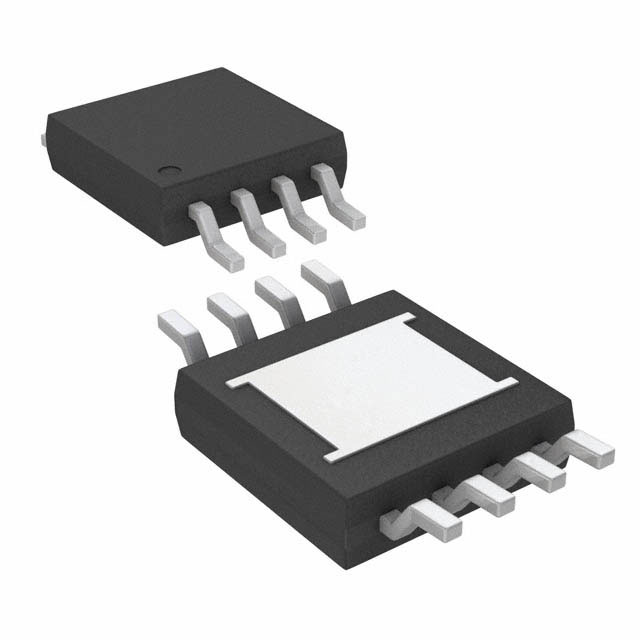LTC3448EMS8E#PBF
Product Overview
- Category: Integrated Circuit (IC)
- Use: Power Management
- Characteristics: High Efficiency, Low Quiescent Current, Small Package Size
- Package: MSOP-8
- Essence: Voltage Regulator
- Packaging/Quantity: Tape & Reel, 2500 units per reel
Specifications
- Input Voltage Range: 2.7V to 5.5V
- Output Voltage Range: 1.8V to 5V
- Maximum Output Current: 400mA
- Quiescent Current: 20µA
- Switching Frequency: 1.5MHz
- Operating Temperature Range: -40°C to 125°C
Pin Configuration
The LTC3448EMS8E#PBF has the following pin configuration:
```
| | --| VIN GND |-- Pin 1 --| SW FB |-- Pin 2 --| EN VOUT|-- Pin 3 --| PG LX |-- Pin 4 |___________| ```
Functional Features
- High efficiency synchronous buck regulator
- Low quiescent current for extended battery life
- Wide input voltage range suitable for various applications
- Adjustable output voltage with high accuracy
- Internal soft-start limits inrush current during startup
- Overcurrent and overtemperature protection
- Power Good (PG) signal indicates output voltage within regulation
Advantages and Disadvantages
Advantages: - High efficiency operation reduces power dissipation - Small package size saves board space - Wide input voltage range allows flexibility in power supply design - Low quiescent current extends battery life - Overcurrent and overtemperature protection ensures device safety
Disadvantages: - Limited maximum output current (400mA) - Requires external components for operation
Working Principles
The LTC3448EMS8E#PBF is a high efficiency synchronous buck regulator. It takes an input voltage within the range of 2.7V to 5.5V and converts it to a regulated output voltage between 1.8V and 5V. The regulator operates at a switching frequency of 1.5MHz, allowing for smaller external components.
The device uses a synchronous rectification topology to achieve high efficiency. It employs a pulse width modulation (PWM) control scheme to regulate the output voltage. The internal soft-start feature limits the inrush current during startup, preventing excessive stress on the components.
The LTC3448EMS8E#PBF also incorporates overcurrent and overtemperature protection mechanisms to ensure safe operation. The Power Good (PG) signal indicates when the output voltage is within regulation, providing a convenient way to monitor the power supply status.
Detailed Application Field Plans
The LTC3448EMS8E#PBF is suitable for various applications that require efficient power management. Some potential application fields include:
Portable Electronics: The low quiescent current and wide input voltage range make it ideal for battery-powered devices such as smartphones, tablets, and portable media players.
IoT Devices: With its small package size and high efficiency, the LTC3448EMS8E#PBF can be used in IoT devices like smart sensors, wearables, and connected home appliances.
Industrial Equipment: The regulator's ability to operate in a wide temperature range (-40°C to 125°C) makes it suitable for industrial applications, including automation systems, control panels, and motor drives.
Automotive Electronics: The LTC3448EMS8E#PBF can be utilized in automotive electronics, such as infotainment systems, advanced driver-assistance systems (ADAS), and lighting control modules.
Detailed and Complete Alternative Models
- LTC3448EMS8E#TRPBF: Similar to LTC3448EMS8E#PBF, but available in tape & reel packaging with 3000 units per reel.
- LTC3448IMS8E#PBF: A variant of LTC3448EMS8E#PBF with a different input voltage range (2.7V to 4.5V) and maximum output current (600mA).
- LTC3448HMS8E#PBF: Another alternative with a higher maximum output current (800mA) and extended temperature range (-40°C to 150°C).
These alternative models offer similar functionality and can be considered based on specific application requirements.
Word count: 570 words
Lista 10 Vanliga frågor och svar relaterade till tillämpningen av LTC3448EMS8E#PBF i tekniska lösningar
Sure! Here are 10 common questions and answers related to the application of LTC3448EMS8E#PBF in technical solutions:
Q: What is LTC3448EMS8E#PBF? A: LTC3448EMS8E#PBF is a high-efficiency, synchronous buck-boost DC/DC converter IC manufactured by Linear Technology (now part of Analog Devices).
Q: What is the input voltage range of LTC3448EMS8E#PBF? A: The input voltage range of LTC3448EMS8E#PBF is from 2.7V to 16V.
Q: What is the output voltage range of LTC3448EMS8E#PBF? A: The output voltage range of LTC3448EMS8E#PBF is adjustable from 2.5V to 14V.
Q: What is the maximum output current of LTC3448EMS8E#PBF? A: The maximum output current of LTC3448EMS8E#PBF is typically 2A.
Q: Can LTC3448EMS8E#PBF be used for both step-up and step-down applications? A: Yes, LTC3448EMS8E#PBF is a versatile buck-boost converter that can be used for both step-up and step-down voltage conversions.
Q: Does LTC3448EMS8E#PBF have built-in protection features? A: Yes, LTC3448EMS8E#PBF includes various protection features such as overcurrent protection, thermal shutdown, and undervoltage lockout.
Q: What is the switching frequency of LTC3448EMS8E#PBF? A: The switching frequency of LTC3448EMS8E#PBF is typically 1.2MHz.
Q: Can LTC3448EMS8E#PBF operate in a wide temperature range? A: Yes, LTC3448EMS8E#PBF can operate in a temperature range from -40°C to 125°C.
Q: What type of package does LTC3448EMS8E#PBF come in? A: LTC3448EMS8E#PBF is available in an 8-pin MSOP (Mini Small Outline Package).
Q: What are some typical applications of LTC3448EMS8E#PBF? A: LTC3448EMS8E#PBF is commonly used in battery-powered systems, portable devices, industrial equipment, and automotive applications where efficient voltage conversion is required.
Please note that the answers provided here are general and may vary depending on specific datasheet specifications and application requirements.


